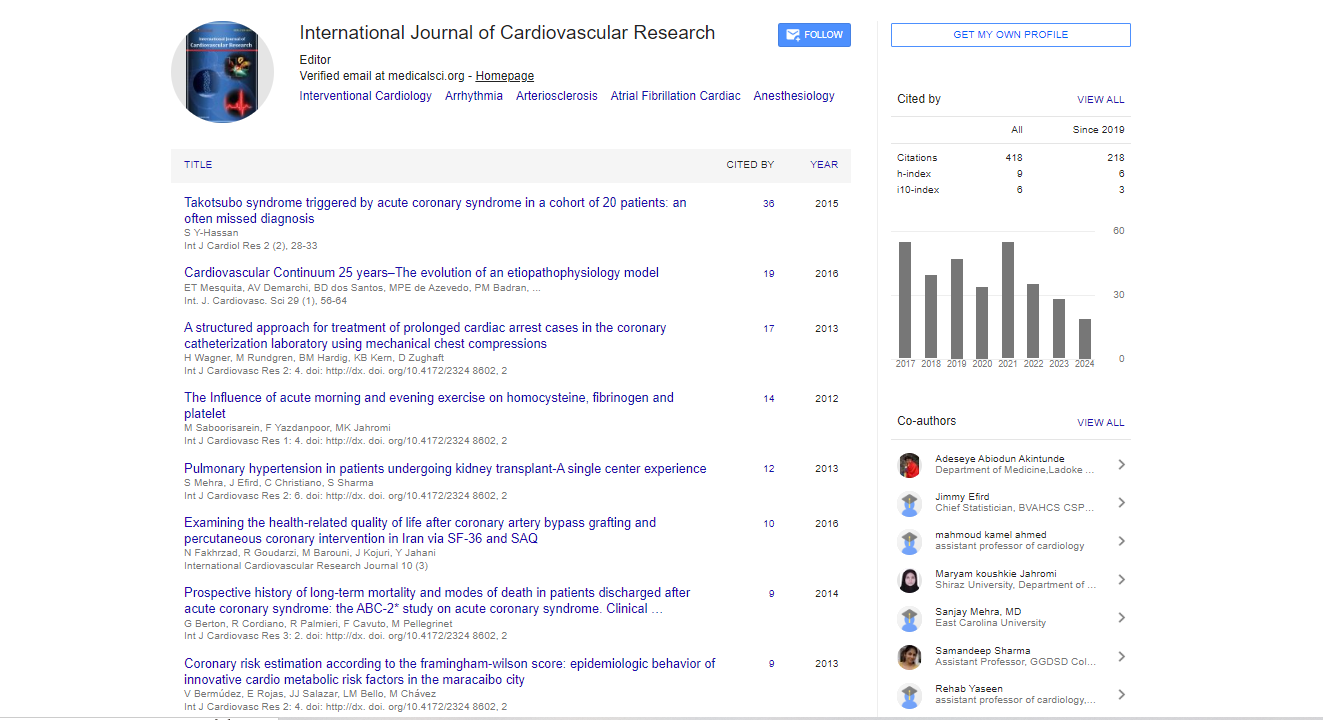Opinion Article, Int J Cardiol Res Vol: 13 Issue: 5
Bioprosthetic Valve Therapy in Cardiovascular Treatment
Maria Lopez*
1Department of Cardiology, Stanford University School of Medicine, California, United States of America
*Corresponding Author:Maria Lopez,
Department of Cardiology, Stanford
University School of Medicine, California, United States of America
E-mail: maria.lopez@studymail.com
Received date: 23 September, 2024 Manuscript No. ICRJ-24-153164;
Editor assigned date: 25 September, 2024, PreQC No. ICRJ-24-153164 (PQ);
Reviewed date: 09 October, 2024, QC No. ICRJ-24-153164;
Revised date: 16 October, 2024, Manuscript No. ICRJ-24-153164 (R);
Published date: 23 October, 2024, DOI: 10.4172/2324-8602.1000589.
Citation: Lopez M (2024) Bioprosthetic Valve Therapy in Cardiovascular Treatment. Int J Cardiol Res 13:5.
Description
Bioprosthetic valve therapy has emerged as a revolutionary solution for patients with valvular heart disease, offering an alternative to traditional mechanical valves. The therapy involves the implantation of biologically derived valves, providing a promising treatment option for individuals suffering from various forms of valve dysfunction, particularly in older populations. Bioprosthetic valves are valves derived from biological tissues, most commonly sourced from animals such as pigs (porcine valves) or cows (bovine pericardial valves), or human cadavers. The biological tissue is treated to prevent immune rejection and calcification, a major issue in the longevity of these valves. These valves are used primarily to replace damaged or diseased heart valves in patients with conditions such as aortic stenosis, mitral regurgitation and other forms of valve insufficiency. The biological tissue used in these valves is processed to eliminate living cells, which reduces the risk of immune rejection. The tissue is then cross-linked to minimize calcification, the primary concern affecting the durability of bioprosthetic valves. The valves are mounted on a metal or plastic frame, known as a stent, which facilitates their implantation during surgery. Bioprosthetic valves are typically used in patients who are unsuitable for mechanical valves due to their age or other factors, as well as in those who prefer a lower risk of long-term complications. One of the key advantages of bioprosthetic valve therapy is the reduced need for lifelong anticoagulation therapy compared to mechanical valves. Mechanical valves, while highly durable, require patients to take blood-thinning medications to prevent the formation of blood clots on the valve surface. This lifelong medication regimen presents significant risks, including bleeding complications and the need for frequent monitoring. In contrast, bioprosthetic valves, being biologically derived, present a lower risk of thromboembolic events, allowing most patients to avoid the need for continuous anticoagulation therapy.
Additionally, bioprosthetic valves have a lower risk of valve thrombosis and thromboembolic events compared to mechanical valves. This makes them an ideal choice for older patients or those with a higher risk of bleeding. The absence of anticoagulation therapy greatly improves the patient’s quality of life, reducing hospital visits and enhancing their overall well-being. Another advantage is the more natural hemodynamic performance of bioprosthetic valves. These valves, especially those with porcine and bovine tissue, exhibit better flow characteristics than mechanical valves. The smooth surface and tissue composition of the bioprosthetic valves allow for more natural blood flow through the heart, reducing the risk of complications such as hemolysis (destruction of red blood cells) and valve-related dysfunction. Recent advances in bioprosthetic valve technology have focused on improving valve durability and minimizing the risk of calcification. Studyers are analyzing new methods of tissue preservation and cross-linking to further enhance the longevity of bioprosthetic valves. One promising area of study involves the use of decellularized tissue, in which the living cells of the biological tissue are removed, leaving behind only the extracellular matrix. This approach helps prevent immune rejection and may reduce the likelihood of calcification, thereby increasing the valve’s durability. Additionally, advancements in valve design, such as the development of self-expanding stents and improvements in valve geometry, have made the implantation process less invasive. These innovations have led to minimally invasive surgical options, such as Transcatheter Aortic Valve Replacement (TAVR), which allows for the implantation of bioprosthetic valves via a catheter inserted through a blood vessel, rather than requiring open-heart surgery. TAVR has revolutionized the treatment of aortic stenosis, particularly in elderly patients who are high-risk candidates for traditional surgery.
Conclusion
Bioprosthetic valve therapy represents a major advancement in the field of cardiovascular medicine, offering a less invasive, lower-risk alternative to mechanical valve replacement. While challenges related to durability and calcification remain, ongoing study and technological advancements are composed to address these limitations. As bioprosthetic valve therapy continues to evolve, it is set to play an increasingly significant role in improving the lives of patients with valvular heart disease, providing them with a valuable option for treatment in the years to come.
 Spanish
Spanish  Chinese
Chinese  Russian
Russian  German
German  French
French  Japanese
Japanese  Portuguese
Portuguese  Hindi
Hindi 



